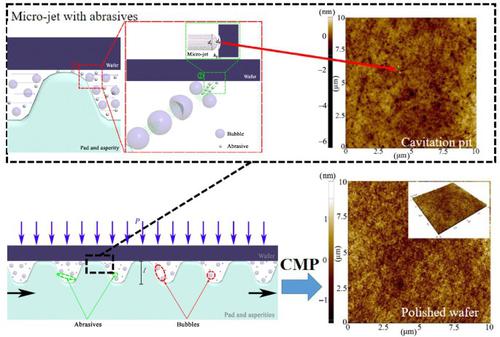Friction ( IF 6.8 ) Pub Date : 2023-03-25 , DOI: 10.1007/s40544-022-0668-8 Lei Xu , Kihong Park , Hong Lei , Pengzhan Liu , Eungchul Kim , Yeongkwang Cho , Taesung Kim , Chuandong Chen

|
The material loss caused by bubble collapse during the micro-nano bubbles auxiliary chemical mechanical polishing (CMP) process cannot be ignored. In this study, the material removal mechanism of cavitation in the polishing process was investigated in detail. Based on the mixed lubrication or thin film lubrication, bubble—wafer plastic deformation, spherical indentation theory, Johnson—Cook (J—C) constitutive model, and the assumption of periodic distribution of pad asperities, a new model suitable for micro-nano bubble auxiliary material removal in CMP was developed. The model integrates many parameters, including the reactant concentration, wafer hardness, polishing pad roughness, strain hardening, strain rate, micro-jet radius, and bubble radius. The model reflects the influence of active bubbles on material removal. A new and simple chemical reaction method was used to form a controllable number of micro-nano bubbles during the polishing process to assist in polishing silicon oxide wafers. The experimental results show that micro-nano bubbles can greatly increase the material removal rate (MRR) by about 400% and result in a lower surface roughness of 0.17 nm. The experimental results are consistent with the established model. In the process of verifying the model, a better understanding of the material removal mechanism involved in micro-nano bubbles in CMP was obtained.
中文翻译:

化学诱导的活性微纳米气泡辅助化学机械抛光:建模和实验
微纳米气泡辅助化学机械抛光(CMP)过程中气泡破裂造成的材料损失不容忽视。在这项研究中,详细研究了抛光过程中空化的材料去除机制。基于混合润滑或薄膜润滑、气泡—晶圆塑性变形、球形压痕理论、Johnson—Cook (J—C)本构模型,以及焊盘凹凸周期分布假设,适用于微纳米气泡的新模型开发了 CMP 中的辅助材料去除。该模型集成了许多参数,包括反应物浓度、晶片硬度、抛光垫粗糙度、应变硬化、应变率、微射流半径和气泡半径。该模型反映了活性气泡对材料去除的影响。采用全新且简单的化学反应方法,在抛光过程中形成数量可控的微纳米气泡,辅助抛光氧化硅晶圆。实验结果表明,微纳米气泡可将材料去除率 (MRR) 大幅提高约 400%,并使表面粗糙度降低至 0.17 nm。实验结果与建立的模型一致。在验证模型的过程中,对CMP中微纳米气泡所涉及的材料去除机制有了更好的理解。实验结果表明,微纳米气泡可将材料去除率 (MRR) 大幅提高约 400%,并使表面粗糙度降低至 0.17 nm。实验结果与建立的模型一致。在验证模型的过程中,对CMP中微纳米气泡所涉及的材料去除机制有了更好的理解。实验结果表明,微纳米气泡可将材料去除率 (MRR) 大幅提高约 400%,并使表面粗糙度降低至 0.17 nm。实验结果与建立的模型一致。在验证模型的过程中,对CMP中微纳米气泡所涉及的材料去除机制有了更好的理解。



























 京公网安备 11010802027423号
京公网安备 11010802027423号